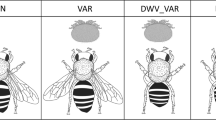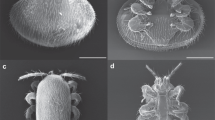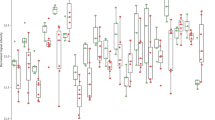Abstract
Tropilaelaps mercedesae, an ectoparasitic mite of honeybees, is currently a severe health risk to Apis mellifera colonies in Asia and a potential threat to the global apiculture industry. However, our understanding of the physiological and developmental regulation of this pest remains significantly insufficient. Using ultra-high resolution mass spectrometry, we provide the first comprehensive proteomic profile of T. mercedesae spanning its entire post-embryonic ontogeny, including protonymphs, deutonymphs, mature adults, and reproductive mites. Consequently, a total of 4,422 T. mercedesae proteins were identified, of which 2,189 proteins were significantly differentially expressed (FDR < 0.05) throughout development and maturation. Our proteomic data provide an important resource for understanding the biology of T. mercedesae, and will contribute to further research and effective control of this devastating honeybee pest.
Similar content being viewed by others
Background & Summary
The honeybee (Apis mellifera) is an important economic insect that is extensively reared around the world. The pollination services provided by honeybees make them irreplaceable in protecting biodiversity and maintaining food security1,2. Nevertheless, a variety of biotic and abiotic factors have put severe pressure on the health of honeybees, leading to increased attention on their survival3,4. Among the stresses, ectoparasitic mites are the most prominent biotic stressors threatening honeybees, and the Varroa destructor (Mesostigmata: Varroidae) has been a global epidemic5,6,7, making it one of the primary research focuses8,9,10. However, another obligate ectoparasitic mite, Tropilaelaps mercedesae (Mesostigmata: Laelapidae), which is widely prevalent in Asia and causes serious damage to A. mellifera, also poses a risk of global spread11.
T. mercedesae has shifted from its original host, the giant Asian honeybee species (Apis breviligula, Apis dorsata, and Apis laboriosa), to A. mellifera for over half a century, and has now well adapted to parasitizing its new host, feeding on it, and transferring viruses12,13. Similar to the Varroa mites, the life cycle of T. mercedesae also includes alternates between reproductive and dispersal stages. The entire reproductive stage unfolds within the capped brood cells, initiating with a mature female entering the cell just before capping and beginning to lay eggs about 10 hours after capping, laying eggs approximately every 24 hours. Upon hatching, the eggs develop to maturity after passing through the protonymph stage and the deutonymph stage. During this period, the foundress mite and her offspring feed on the hemolymph of honeybee pupae14. By the time their host bees emerge from the cell, almost all female T. mercedesae offspring have become mature adults, emerge together with their hosts, and enter the next reproductive cycle15. Unlike Varroa mites, the dispersal phase of T. mercedesae is much shorter and they do not feed on adults. Instead, they feed on young larvae in uncapped cells16,17, as their body size and mouthparts are not suitable for parasitizing and feeding on adult bees18. The combination of an accelerated reproductive rate, truncated life cycle, and abbreviated dispersal phase collectively underpin the rapid proliferation of T. mercedesae within honeybee colonies, potentially endowing it with a heightened capacity to compromise bee health compared to Varroa. However, current research on the molecular biology of T. mercedesae is still limited, constraining a profound understanding and effective control of it.
In the current study, applying ultra-high-resolution mass spectrometry, we performed the first comprehensive proteomic profiling of T. mercedesae across all post-embryonic developmental stages (i.e., protonymph, deutonymph, adult, and reproductive stages). The data generated will provide an important resource for understanding the biology and developmental regulation of T. mercedesae, and will help to develop effective treatments for this devastating honeybee pest.
Methods
Sample collection
Tropilaelaps mercedesae samples were collected from 12 honeybee (Apis mellifera) colonies in three apiaries (four colonies from each apiary) located in Beijing, Tianjin, and Hebei, China. All colonies were queen right and managed using standard apicultural practices, except they were not treated to control mite populations.
All T. mercedesae samples were collected from capped brood cells using a soft paintbrush and soft tweezers. Reproductive mites (Rep) were collected from brood cells containing white-eyed pupae. Protonymphs (Pro) and one deutonymphs (Deu) were sampled from brood cells containing purple-eyed pupae. Adult T. mercedesae (Adu) were collected from cells close to emerging (about one day before adult bees emerged).
For each group (protonymphs, deutonymphs, adults, and reproductive mites), collected mites from all 12 colonies were randomly allocated to one of three replicates (50 mg for each replicate). All samples were rinsed with PBS and air-dried to remove many contaminates that may have been attached to the cuticle, flash-frozen using liquid nitrogen, and stored at −80 °C for further processing.
Preparation of peptide extracts for proteomic analysis
Mite samples were homogenized at 4 °C using SDT buffer (4% SDS, 100 mM Tris-HCl, 1 mM DTT, pH 7.6) for sample lysis and protein extraction. The contrition of protein was quantified with the BCA Protein Assay Kit (Bio-Rad, USA). The general quality of extracted proteins was confirmed by SDS-PAGE: 20 µg of protein for each sample were mixed with 5X loading buffer respectively and boiled for 5 min. The proteins were separated on 12.5% SDS-PAGE gel (constant current 14 mA, 90 min). Protein bands were visualized by Coomassie Blue staining.
Protein digestion by trypsin was performed according to the filter-aided sample preparation (FASP) procedure described previously19. In brief, 200 μg of proteins for each sample were incorporated into 30 μl SDT buffer (4% SDS, 150 mM Tris-HCl, 100 mM DTT, pH 8.0). The detergent, DTT and other low-molecular-weight components were removed using UA buffer (8 M Urea, 150 mM Tris-HCl, pH 8.0) by repeated ultrafiltration (Microcon units, 10 kDa). Then 100 μl iodoacetamide (100 mM IAA in UA buffer) was added to block reduced cysteine residues and the samples were incubated for 30 min in darkness. The filters were washed with 100 μl UA buffer three times and then 100 μl 25 mM NH4HCO3 buffer twice. Finally, the protein suspensions were digested with 4 μg trypsin (Promega) in 40 μl 25 mM NH4HCO3 buffer overnight at 37 °C, and the resulting peptides were collected as a filtrate. The peptides of each sample were desalted on C18 Cartridges (Empore™ SPE Cartridges C18, bed I.D. 7 mm, volume 3 ml, Sigma), dried by vacuum centrifugation and dissolved in 0.1% formic acid in distilled water, then quantified using a NanoDrop 2000 spectrophotometer (Thermo Fisher Scientific) and stored at −80 °C for subsequent LC-MS/MS analysis.
Liquid chromatography tandem mass spectrometry (LC-MS/MS) analysis
Data Dependent Acquisition (DDA) Mass Spectrometry Assay: All fractions for DDA library generation were analysed by a Thermo Scientific Q Exactive HF mass spectrometer connected to an Easy nLC 1200 chromatography system (Thermo Scientific). The peptide (1.5 μg) was first loaded onto an EASY-SprayTM C18 Trap column (Thermo Scientific, P/N 164946, 2 cm long, 75 µm inner diameter, 3 μm resin), then separated on an EASY-SprayTM C18 LC Analytical Column (Thermo Scientific, ES802, 25 cm long, 75 µm inner diameter, 2 μm resin) with a linear gradient of buffer B (84% acetonitrile and 0.1% formic acid) at a flow rate of 250 nl/min over 90 min. MS detection method was positive ion, the scan range was 300–1,800 m/z, resolution for MS1 scan was 60,000 at 200 m/z, target of AGC (automatic gain control) was 3e6, maximum IT was 25 ms, dynamic exclusion was 30 s. Each full MS–SIM scan followed 20 MS2 scans. The Resolution for MS2 scan was 15,000, AGC target was 5e4, maximum IT was 25 ms, and normalized collision energy was 30 eV.
Mass spectrometry data processing and statistical analysis
The extracted MS/MS spectra were searched against a protein database combined with Tropilaelaps mercedesae, Apis mellifera, and all viruses known to infect Apis mellifera (37,955 protein sequences in total from NCBI) and appended with the common contaminants using MaxQuant (v. 2.4.2.0). The search parameters were as follows: MS1 match tolerance: 20 ppm for the first search and 6 ppm for the main search; MS2 tolerance: 20 ppm; enzyme: trypsin; allow non-specific cleavage at none end of the peptide; maximum missed cleavages per peptide: 2; fixed modification, Carbamidomethylation; variable modifications: Oxidation and Acetylation (N-term); maximum allowed variable PTM per peptide: 3. A fusion target-decoy approach was used for the estimation of false discovery rate (FDR) and controlled at <1.0% both at peptide and protein levels. Proteins were identified based on at least one unique peptide. Protein quantitation analysis was performed using Perseus (v. 1.6.2.3), and the p-values were Benjamini Hochberg-corrected at 5% FDR.
Data Records
The LC-MS/MS row data have been deposited in ProteomeXchange Consortium20 (http://proteomecentral.proteomexchange.org) via the PRIDE partner repository21 with the dataset identifier PXD05134722.
Technical Validation
Quality evaluation of mass spectrometry data
To assess the quality of our mass spectrometry data, we conducted a series of evaluations, including dmass of precursor ion distribution analysis, peptide length distribution analysis, missed cleavage distribution analysis, and protein coverage distribution analysis. The dmass of precursor ions before and after recalibration were normally distributed and mainly distributed within ± 2.5 ppm, showing that the quality accuracy of the mass spectrometry is ideal (Fig. 1a). Most of the peptides detected by mass spectrometry were distributed in the range of 7–20 amino acids, which conform to the general rules of enzymatic digestion and mass spectrometry fragmentation (Fig. 1b). The proportion of peptides with missed cleavages of 0 and 1 was over 98%, confirming that the enzyme digestion is complete and favourable for identification (Fig. 1c). The protein coverage is positively correlated with its abundance in the sample, and in our data, the proportion of proteins with coverage higher than 10% accounts for about 80%, indicating that the protein identification is highly credible (Fig. 1d).
Reproducibility within the replicates
To ensure the representativeness of our samples, we collected T. mercedesae from 12 honeybee colonies in three apiaries, and prepared three biological replicates for each group of samples. The combination of box plots and violin plots indicates good consistency between our biological replicates (Fig. 2a). Using the unsupervised principal component analysis (PCA) model, the stability and reproducibility of all data sets were monitored. As shown in Fig. 2b, samples from the same group were tightly clustered together and separated from other groups, showing that there is a large overall protein difference between groups, while the variation within the groups is small. The correlation analysis between samples can be used to observe the biological replication between samples within the group. The correlation analysis results showed that the Pearson’s Correlation Coefficient (R) within all four groups of samples is greater than 0.99, which is higher than the R between groups (Fig. 2c), indicating that the obtained differential proteins have high reliability.
Reproducibility within the replicates. (a) Distribution of protein abundance in each sample. The box plots show the degree of dispersion of the protein expression level (abundance), and the violin plots display the distribution and probability density of protein expression levels. (b) PCA plot based on the complete proteomic dataset. (c) Correlation plot between samples. Pro: protonymphs; Deu: deutonymphs; Adu: adult mites; and Rep: reproductive mites.
Code availability
Data analysis procedures have been described in detail in the Methods section. No custom code was used during this study for the curation and/or validation of the dataset.
References
Potts, S. G. et al. Safeguarding pollinators and their values to human well-being. Nature 540, 220–229 (2016).
Klein, A.-M. et al. Importance of pollinators in changing landscapes for world crops. Proc. R. Soc. B. 274, 303–313 (2007).
Vanbergen, A. J. & Initiative, T. I. P. Threats to an ecosystem service: pressures on pollinators. Front. Ecol. Environ. 11, 251–259 (2013).
Goulson, D. & Nicholls, E. Anthropogenic influences on bee foraging. Science 375, 970–972 (2022).
Martin, S. J. et al. Global honey bee viral landscape altered by a parasitic mite. Science 336, 1304–1306 (2012).
Nazzi, F. & Le Conte, Y. Ecology of Varroa destructor, the major ectoparasite of the western honey bee, Apis mellifera. Annu. Rev. Entomol. 61, 417–432 (2016).
Traynor, K. S. et al. Varroa destructor: A complex parasite, crippling honey bees worldwide. Trends Parasitol. 36, 592–606 (2020).
Yang, X. & Cox-Foster, D. L. Impact of an ectoparasite on the immunity and pathology of an invertebrate: evidence for host immunosuppression and viral amplification. Proc. Natl. Acad. Sci. USA 102, 7470–7475 (2005).
Zheng, H. et al. Genomic signatures underlying the oogenesis of the ectoparasitic mite Varroa destructor on its new host Apis mellifera. J. Adv. Res. 44, 1–11 (2023).
Pusceddu, M. et al. Honey bees increase social distancing when facing the ectoparasite Varroa destructor. Sci. Adv. 7, eabj1398 (2021).
Chantawannakul, P., Ramsey, S., vanEngelsdorp, D., Khongphinitbunjong, K. & Phokasem, P. Tropilaelaps mite: an emerging threat to European honey bee. Curr. Opin. Insect Sci. 26, 69–75 (2018).
de Guzman, L. I., Williams, G. R., Khongphinitbunjong, K. & Chantawannakul, P. Ecology, life history, and management of Tropilaelaps mites. J. Econ. Entomol. 110, 319–332 (2017).
Forsgren, E., de Miranda, J. R., Isaksson, M., Wei, S. & Fries, I. Deformed wing virus associated with Tropilaelaps mercedesae infesting European honey bees (Apis mellifera). Exp. Appl. Acarol. 47, 87–97 (2009).
Han, B. et al. Life-history stage determines the diet of ectoparasitic mites on their honey bee hosts. Nat. Commun. 15, 725 (2024).
Khongphinitbunjong, K. et al. Observations on the removal of brood inoculated with Tropilaelaps mercedesae (Acari: Laelapidae) and the mite’s reproductive success in Apis mellifera colonies. Exp. Appl. Acarol. 62, 47–55 (2014).
Phokasem, P., de Guzman, L. I., Khongphinitbunjong, K., Frake, A. M. & Chantawannakul, P. Feeding by Tropilaelaps mercedesae on pre-and post-capped brood increases damage to Apis mellifera colonies. Sci. Rep. 9, 1–12 (2019).
Ling, T. C. et al. Tropilaelaps mercedesae infestation is correlated with injury numbers on the brood and the population size of honey bee Apis mellifera. Animals 13, 1318 (2023).
Anderson, D. L. & Roberts, J. M. Standard methods for Tropilaelaps mites research. J. Apic. Res. 52, 1–16 (2013).
Wisniewski, J. R., Zougman, A., Nagaraj, N. & Mann, M. Universal sample preparation method for proteome analysis. Nat. Methods 6, 359–362 (2009).
Vizcaino, J. A. et al. ProteomeXchange provides globally coordinated proteomics data submission and dissemination. Nat. Biotech. 32, 223–226 (2014).
Vizcaíno, J. A. et al. The PRoteomics IDEntifications (PRIDE) database and associated tools: status in 2013. Nucleic Acids Res. 41, D1063–D1069 (2013).
Han, B. et al. PRIDE Archive. https://identifiers.org/pride.project:PXD051347 (2024).
Acknowledgements
We would like to thank Zhonghua Zhao for his help in colony management This study was funded by the Modern Agro-Industry Technology Research System (Grant No. CARS-44-KXJ-6) to S.X., and the Agricultural Science and Technology Innovation Program (Grant No. CAAS-ASTIP-2023-IAR).
Author information
Authors and Affiliations
Contributions
B.H. and S.X. designed the research; Q.W., J.W., F.L., J.S., W.K., M.Z., W.F. and C.Z. collected the sample and performed the experiments; Q.W., J.W. and B.H. analyzed the data; S.X. provided resources; Q.W., J.W. and B.H. wrote the paper; and B.H. and S.X. edited the manuscript.
Corresponding authors
Ethics declarations
Competing interests
The authors declare no competing interests.
Additional information
Publisher’s note Springer Nature remains neutral with regard to jurisdictional claims in published maps and institutional affiliations.
Rights and permissions
Open Access This article is licensed under a Creative Commons Attribution 4.0 International License, which permits use, sharing, adaptation, distribution and reproduction in any medium or format, as long as you give appropriate credit to the original author(s) and the source, provide a link to the Creative Commons licence, and indicate if changes were made. The images or other third party material in this article are included in the article’s Creative Commons licence, unless indicated otherwise in a credit line to the material. If material is not included in the article’s Creative Commons licence and your intended use is not permitted by statutory regulation or exceeds the permitted use, you will need to obtain permission directly from the copyright holder. To view a copy of this licence, visit http://creativecommons.org/licenses/by/4.0/.
About this article
Cite this article
Wei, Q., Wu, J., Liu, F. et al. Proteomics profiling of the honeybee parasite Tropilaelaps mercedesae across post-embryonic development. Sci Data 11, 498 (2024). https://doi.org/10.1038/s41597-024-03355-4
Received:
Accepted:
Published:
DOI: https://doi.org/10.1038/s41597-024-03355-4





